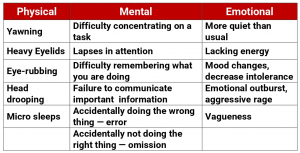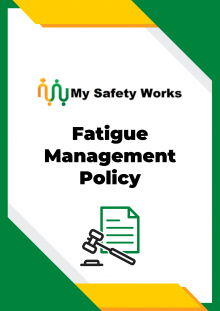Description
What is Fatigue?
Fatigue can be described as weariness that is primarily caused by prolonged wakefulness or insufficient and/or disturbed sleep. When you are fatigued, you feel mentally and physically tired and may find it hard to do even simple tasks.

Signs and Symptoms of Fatigue
Fatigue can be caused by several factors, including:
- Lack of sleep. Most adults need 7-8 hours of sleep per night. When you don’t get enough sleep, you are more likely to feel fatigued.
- Physical activity. Fatigue is a normal side effect of physical activity. However, if you are not used to exercising, or if you are overexerting yourself, you may feel more fatigued than usual.
- Illness. Fatigue can be a symptom of many different illnesses, such as the common cold and the flu. Fatigue can also be a symptom of more serious illnesses, such as cancer, anemia, and heart disease.
- Medications. Some medications can cause fatigue as a side effect.
- Stress. Emotional stress can also cause fatigue.
- Mental health conditions. Fatigue is a common symptom of mental health conditions such as depression and anxiety.
Note: A work environment in which employees do not feel threatened or subjected to criticism by disclosure of fatigue will improve an organization’s capabilities to better manage fatigue-related risks.
What is a Fatigue Management Policy?
A fatigue management policy is a set of guidelines and key principles that outline processes to manage fatigue-related risks and protect employees from the dangers of fatigue.
Fatigue can lead to serious incidents and it is important to have a policy in place to prevent these accidents. A fatigue management policy is critical for any organization whose employees work long hours or have physically demanding jobs.
How to Identify Fatigue
Identifying and assessing the risks of fatigue can be difficult because people respond differently to situations that may contribute to fatigue, however generally fatigue is due to normal body rhythms that regulate sleep being disrupted, or because there is inadequate time for rest and recovery.
Personnel who work long hours, nights or unscheduled shifts tend to have a sleep deficit build up over time due to poor or little sleep.
Fatigue can also be caused by many other things too, including physical activity, stress, anxiety, depression, medications, and lack of sleep. It can also be a symptom of an underlying medical condition, such as anaemia, diabetes, heart disease, or thyroid problems.
How to Implement a Fatigue Management Policy
There are many things to consider when you are implementing a fatigue management policy.
Here are some tips to help you get started.
- Education and training your team on the risks of fatigue and how to manage it.
- Develop a clear procedure that outlines what is expected of employees in terms of managing their fatigue.
- Make sure employees have the opportunity to provide input into the fatigue management procedure.
- Ensure employees are aware of the consequences of non-compliance with the procedure.
What About Hours of Work?
For the effects of fatigue to be controlled or minimized, ongoing assessment and consultation between management and workers should be undertaken. In particular, workers should be encouraged to remain alert to their well-being and draw attention to any concerns they may have about fatigue.
Regular hours of work should be determined through a consultation process with consideration to:
- The total number of hours worked in a shift.
- The length of consecutive work shifts.
- The intensity of the work (consider both the mental and physical aspects).
- The length of breaks between shifts.
- The number of breaks within a shift.
- The number of days free from work.
- The number of night shifts worked especially consecutive night shifts.
These factors should be considered to assess the risks of fatigue in situations where work patterns, such as shift work, extended hours and on-call arrangements are involved.
Why Choose to Buy this Fatigue Management Policy?
This 1-page fatigue management policy can provide you with clear guidelines and management principles to minimize fatigue-related risks in the workplace and:
- Clearly define responsibilities in maintaining personal fitness for work.
- Outline the general standard for hours of work.
- Provide guidelines for identifying and managing fatigue-related risks in the workplace.
After purchasing this fatigue management policy you will be able to:
- Very easily edit and customize the template to create your own fatigue management policy.
- Apply your own style, format and brand to the policy.
- Use it in any industry or sector regardless of size or type of organization.
Availability and Use of this Fatigue Management Policy
- This fatigue management policy is accessible to you right now by clicking the ‘Buy Now’ button.
- The policy will be delivered to you in fully editable Microsoft Word format for immediate and full use in your business.
- There are no subscriptions, contracts or ongoing costs.

This fatigue management policy is 100% satisfaction guaranteed.
You may also require:


